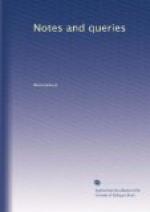T.H.T
Let me refer Mr. P. Cunningham to “Stow’s Survey, p. 27. 92. Thoms’ Edition,” for a full answer to his query. The passages are too long to cite, but Mr. C. will find sufficient proof of the part of a royal residence having once stood in this obscure lane, now almost demolished in the sweeping city improvements, which threaten in time to leave us hardly a fragment of the London of the old chronicler.
The Tower was also called the Queen’s Wardrobe, and it was there, Froissart tells us, that Joan of Kent, the mother of Richard II., took refuge during Wat Tyler’s rebellion, when forced to fly from the Tower of London. The old historian writes that after the defeat of the rebels “pour le premier chemin que le Roy fit, il vint deuers sa Dame de mere, la Princesse, qui estoit en un chastel de la Riolle (que l’on dit la Garderobbe la Reyne) et la s’estoit tenue deux jours et deux nuits, moult ebahie; et avoit bien raison. Quand elle vit le Roy son fils, elle fut toute rejouye, et luy dit, ’Ha ha beau fils, comment j’ay eu aujourd’huy grand peine et angoisse pour vous.’ Dont respondit le Roy, et dit, ’Certes, Madame, je le say bien. Or vous rejouissez et louez Dieu, car il est heure de le louer. J’ay aujourd’huy recouvre mon heritage et le royaume d’Angleterre, que j’avoye perdu.’ Ainsi se tint le Roy ce jour delez sa mere.” (Froissart, ii 123. Par. 1573.)
In Stow’s time this interesting locality had been degraded into stable for the king’s horses, and let out in divers tenements.
E.V.
[We are indebted to J.E., R.T.S., and other correspondents for replies to Mr. Cunningham’s Query; but as their answers contain only general references to works which it is reasonable to suppose that gentleman must have consulted during the preparation of his Handbook for London we have not thought it necessary to insert them.]
* * * * *
ANCIENT INSCRIBED DISH.
Mr. Editor,—The subject of inscribed dishes of latten, of which so many varieties have recently been imported, appears to be regarded with interest by several of your readers. I am indebted to the Rev. William Drake, of Coventry, for a rubbing from one of these mysterious inscriptions, upon an “alms-plate” in his possession. In the centre is represented the Temptation. There are two inscribed circles; on the inner and broader one appear letters, which have been read,—RAHEWISHNBY. They are several times repeated. On the exterior circle is the legend On the exterior circle is the legend—ICH. SART. GELUK. ALZEIT. This likewise is repeated, so as to fill the entire circle. I have never before met with these inscriptions in the large number of dishes of this kind which I have examined. The have been termed alms-dishes, and are used still in parochial collections in France, as doubtless they have been in England. They were




